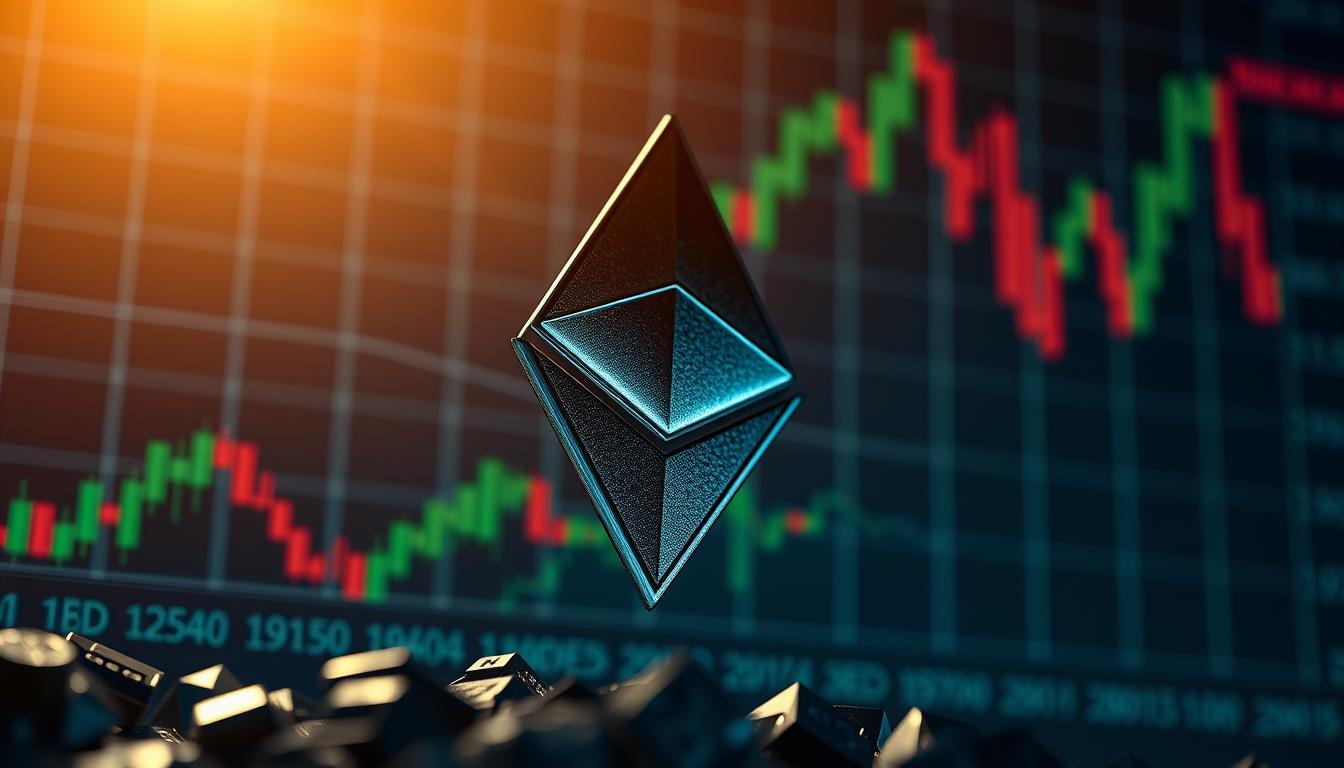Surprising fact: Citigroup’s base forecast pins Ethereum price $4,300 as the likely year-end level, a target that frames how you should think about risk and opportunity now.
You step into a market where analysts at a major bank see three clear scenarios: bearish near $2,200, a base at $4,300, and bullish up to $6,400. That wide band matters because much of recent growth is on Layer-2 networks, and Citi estimates only about 30% of that activity benefits the base chain.
The forecast ties ETF hopes to liquidity: every dollar into ETH products can move markets more than the same dollar in BTC, and institutional buys—like a $200 million acquisition by BitMine Immersion Technologies—add fuel to short-term moves.
Bottom line: you’ll use this analysis to weigh targets, track key support/resistance bands near $4,250–$4,880, and set disciplined risk plans as the year-end approaches.
Key Takeaways
- Citigroup sets a base-case target of Ethereum price $4,300 for year-end.
- Only ~30% of Layer-2 activity is reflected on the base chain, per analysts.
- ETF inflows can amplify moves; institutional buys boost short-term liquidity.
- Watch the $4,250–$4,500 support zone and $4,800–$4,880 resistance band.
- Expect a wide forecast range—plan risk controls and follow market catalysts like macro news and cross-asset signals such as xrp.
Breaking the story: Why Citigroup sees Ethereum price $4,300 by year-end
Citigroup’s latest outlook pulls focus to a realistic end-of-year target for ether markets. The bank frames Ethereum price $4,300 as a baseline while weighing ETF optimism against on-chain fundamentals.
Here are the top takeaways at a glance:
- Forecast range: base-case near $4,300 end, with bearish and bullish tails.
- Timing: consolidation likely through year-end as liquidity and flows balance out.
- What it means for you: plan risk levels and watch key technical bands.
What changed this week? After the coin touched near $4,700 days ago, the market cooled into the low $4,500s as analysts flagged profit-taking. That pullback pressured sentiment and highlighted why only ~30% of Layer-2 activity reaches the base network.
“Models tied to on-chain throughput suggest some recent gains sit above long-run fundamentals,” analysts wrote.
Short-term resistance sits around $4,800–$4,880, while holding $4,500 matters for stability. A failure to hold could lead to a retest near $4,000–$4,100, making the bank’s baseline a useful guide, not a final verdict.
| Metric | Current signal | Why it matters |
|---|---|---|
| On-chain activity | ~30% Layer-2 passthrough | Limits how much network usage supports base valuation |
| Recent move | Tapped ~$4,700 days ago | Shows recent momentum and profit-taking risk |
| Key levels | Hold $4,500 / Resist $4,800–$4,880 | Defines short-term stability and breakout potential |
Inside Citi’s call: Models, activity, and the Ethereum price $4,300 base case

Citi’s models boil complex on-chain signals into three concrete outcomes you can act on. The bank links network metrics, ETF flows and macro inputs to a clear base case that you can use to plan trades and risk limits.
Network activity and Layer-2 dynamics
Only about 30% of Layer-2 activity reaches the base network, Citi notes. That gap means much usage does not add the same settlement value on-chain.
This matters because lower base capture can push models to show a higher short-term level than fundamentals support.
Scenario map and the modeled range
The bank lays out three scenarios so you can anchor expectations:
- Bearish: citigroup bearish path near $2,200.
- Base: the central case near $4,300, where consolidation is likely.
- Bullish: upside to $6,400 if inflows, regulation and macro align.
“Per-dollar inflows into etfs may move eth more than similar BTC flows,” Citi analysts write.
| Input | Signal | Implication |
|---|---|---|
| Layer-2 passthrough | ~30% | Limits base-layer value capture |
| Recent momentum | Cleared $4,250–$4,500 days ago | Sets a consolidation zone before the next leg |
| ETF inflows | High sensitivity | Each dollar may have outsized price impact |
Market mechanics you should watch: ETFs, liquidity, and resistance zones

Small per-dollar inflows into ETH products can create outsized swings when order books are thin. That dynamic makes nearby levels and liquidity pockets more important than usual for managing risk.
ETF inflows vs. price impact
Why inflows matter: etfs can concentrate buying into narrow windows. When that happens, a modest flow can lift the market quickly.
- Per-dollar inflows often move eth price more than similar BTC flows.
- Watch U.S. trading hours—liquidity can dry up and widen spreads in a few hours.
- Institutional buys can push through light resistance, but follow-through needs volume.
Key technical levels and tactical rules
Use clear alerts around reclaimed levels and key bands to stay disciplined.
- Reclaimed zone: $4,250–$4,500 acts as a base; as long as it holds, the midline at Ethereum price $4,300 stays relevant.
- Supply band: resistance sits at $4,800–$4,880 — expect stalls and fading rallies here.
- Risk zone: a daily close below $4,500 warns of a possible retest to $4,000–$4,100.
Support and risk mapping
Translate these levels into actions: set stops, size positions, and avoid chasing breakouts without confirmatory volume.
“Close above $4,880 opens room higher; daily close below $4,500 increases correction risk.”
| Signal | Action | Why it matters |
|---|---|---|
| ETF inflows | Trim or scale in | Per-dollar impact can swing intraday moves |
| Hold $4,500 | Keep core position | Maintains support and reduces dip risk |
| Fail $4,500 | Reduce exposure | Raises odds of $4,000–$4,100 retest |
Also monitor breadth from BTC to xrp to tell if moves are idiosyncratic or market-wide. Use this analysis to keep your playbook systematic and reactive only to confirmed flows and closes.
How this affects your crypto strategy in the United States

Adjust your U.S. trading plan so that clear levels guide every entry and exit.
Keep decisions data-driven. Use Citi’s anchor—Ethereum price $4,300—as a reference, not a rule. Position sizing should respect the $4,500 support band and the $4,800–$4,880 resistance level.
Below is a practical checklist to apply day-to-day.
Practical checklist: assessing risk, sizing positions, and tracking catalysts
- Define baseline: Treat Ethereum price $4,300 as your year-end forecast anchor and plan for consolidation before upside clears resistance.
- Size by support and level clusters: Start small above $4,500, add on confirmed strength through $4,800–$4,880, and trim if eth price closes below $4,500 or drifts toward $4,000–$4,100.
- Track catalysts daily: Watch ETF filings, inflows, network updates, and U.S. macro news; act only when price confirms the headline.
- Monitor institutional activity: Note firms that buy on weakness; the BitMine $200M acquisition shows how balance-sheet buyers can stabilize pullbacks.
- Cross-market checks: Use BTC trend, xrp liquidity, and broader crypto market breadth to avoid overfitting to one coin.
- Two-scenario plan: Stage bids if the forecast level is revisited; use tight trailing stops if price clears resistance on volume.
“Log days and days ago highs to confirm trend durability; your edge is repeatable process and risk control.”
| Signal | Action | Why it matters |
|---|---|---|
| Hold $4,500 support | Maintain core position | Limits downside and preserves optionality |
| Clear $4,880 on volume | Scale in with trailing stops | Confirms breakout and momentum |
| Institutional buys | Watch firms for accumulation | Can provide stabilizing demand |
Most Read:- Cryptocurrency Investing 101: Master the Basics of Crypto
Conclusion
, Use Citi’s range to guide your plan, not to let it drive every trade.
Your takeaway: the base case centers on Ethereum price $4,300 into the year end, with a wide $2,200–$6,400 range that keeps outcomes path dependent.
Stick to levels: protect positions near the $4,500 support and watch $4,800–$4,880 for supply. Keep ETF flows and institutional firms in view; small inflows can move markets fast.
Monitor cross-asset cues like xrp, use the case and range as guardrails, and let real-time price action confirm which scenario is playing out. Stay disciplined and flexible.
FAQ
What did Citigroup predict about ETH by year-end?
Citigroup projected a base-case target of $4,300 for ETH by the end of the year, with a bearish scenario near $2,200 and a bullish view around $6,400. The bank’s model factors in network activity, Layer-2 flows, and potential ETF-related liquidity shifts.
Why does Citi expect a slide despite spot ETF enthusiasm?
Citi argues that ETF flows may not translate one-for-one into on-chain demand. Much transaction activity remains on Layer-2 solutions, so only a portion of demand reaches the main network. That reduces upward price pressure and increases sensitivity to sell-side liquidity.
How reliable are Citi’s scenarios for your strategy?
Scenarios are model-based forecasts, not guarantees. Use them as a risk framework: consider position sizing, set stop levels, and track real-time on-chain metrics and ETF inflows. Diversify and avoid overleveraging based on a single forecast.
Which market mechanics should you monitor closely?
Watch ETF inflows, exchange order books, and Layer-2 to base-layer transfer volumes. Also monitor liquidity at identified resistance and support zones and any sudden changes in mining or staking rewards that could alter supply dynamics.
What technical levels matter right now?
Important zones include a near-term cleared range around $4,250–$4,500 and resistance near $4,800–$4,880. A failure to hold around $4,500 could expose the asset to a retest toward $4,000–$4,100.
How should you size positions given this outlook?
Align position size with your risk tolerance and time horizon. If you’re aiming for longer-term exposure, dollar-cost averaging can reduce timing risk. For shorter-term trades, keep tighter stops and limit leverage, given the elevated volatility.
What on-chain signals would invalidate Citi’s base case?
Sustained increases in base-layer activity, larger-than-expected ETF-driven demand converting to on-chain holdings, and strong inflows to exchange wallets would challenge the downside case and could push valuations above the base scenario.
Could macro or regulatory news change the forecast quickly?
Yes. Policy shifts, U.S. regulatory rulings on ETFs, or large-scale institutional buying or selling can rapidly alter market sentiment and liquidity. Keep an eye on SEC statements and major custody or fund announcements.
How do Layer-2 dynamics affect market share and valuation?
When roughly 30% of activity stays on Layer-2, it reduces transactions recorded on the main chain. That lowers apparent demand for on-chain ETH and can mute price impact from spot-buying, making valuation more dependent on concentrated liquidity flows.
What practical steps should you add to your checklist?
Track ETF weekly inflows, monitor on-chain transfer rates from Layer-2 to the main layer, watch key technical zones, set risk limits, and review exposure relative to portfolio goals. Have alerts for breaches of support or resistance levels.


